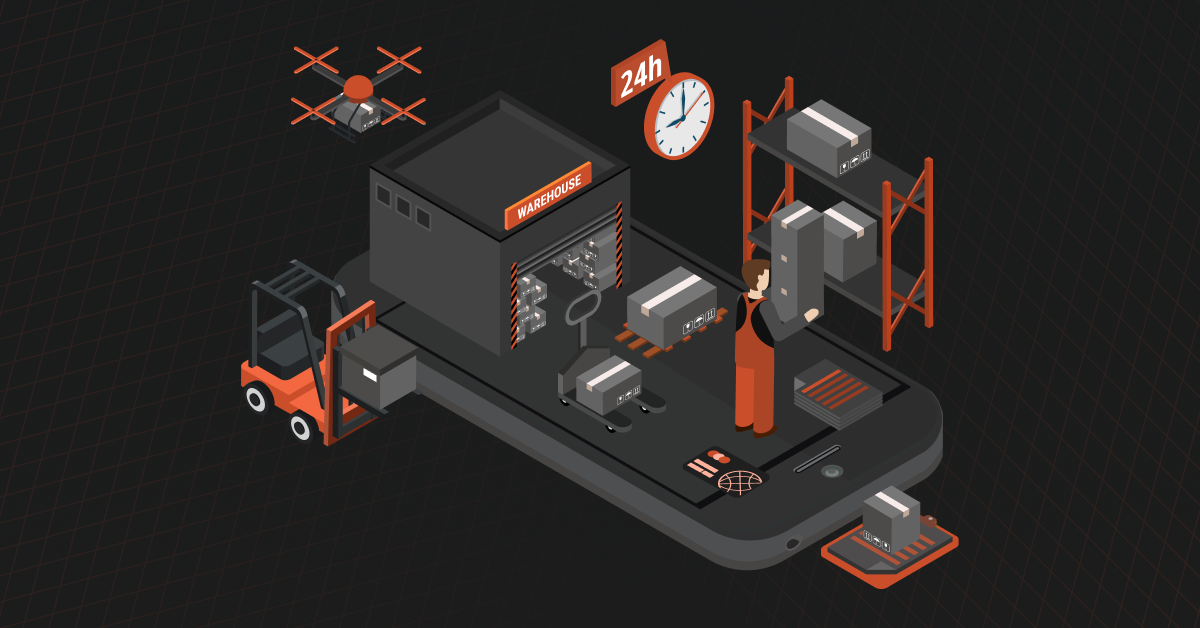Inventory control and warehouse automation are becoming vital for firms trying to improve efficiency, eliminate errors, and scale. Manual methods are inadequate due to increased customer demands, changing supply chains, and real-time data accuracy. Businesses need speed and precision to compete today, so automation helps expedite inventory tracking and order fulfillment.
Types of Warehouse Automation Systems
Simple warehouse automation systems boost efficiency, whereas advanced technologies automate entire inventory management processes. Warehouse automation system types are listed below:
A. Software-Based Warehouse Automation Systems
Barcoding and scanning systems:
Some use barcode labels and portable readers to manually enter data. The warehouse management system (WMS) updates promptly when objects are scanned during picking, packing, or stock checks. This makes efficient inventory management and reduces errors.
Voice-picking systems:
Workers do order picking using voice instructions with voice-picking technologies. The employees wear headsets and receive instructions on what to pick up and where. The hands-free method is faster and more accurate.
AI-Powered Systems:
Fully automatic warehouses leverage AI (artificial intelligence) and ML to streamline procedures. AI can analyze data, predict customer preferences, and adjust operations to save time and money.
End-to-End Automation:
From receiving to sorting, storing, picking, packing, and shipping, most warehouse jobs are automated. AS/RS, robots, automatic conveyors, and WMS/WES are cutting-edge technologies that are used.
Smart Warehouses:
IoT, AI, and automation create smart warehouses that are data-driven and linked. From WMS to robotics, all systems communicate automatically, allowing full visibility and control.
B. Hardware-Based Warehouse Automation Systems
Automated Guided Vehicles (AGVs):
Automated guided vehicles drive goods around the premises. Mobile robots AGVs. They follow programmed lines using markers, lasers, or magnetic strips. AGVs are utilized for repetitive tasks like transferring pallets or materials between workstations.
Autonomous Mobile Robots (AMRs):
Advanced sensors and AI allow AMRs to move around the warehouse without a plan, unlike AGVs. They have more alternatives in warehouses with many regions since they can change routes in real time.
Robotic Picking Systems:
Sensors and artificial arms allow these robots to pluck specific items off shelves. They choose, pack, and sort well, which speeds up order fulfillment, reduces manual labor, and optimizes the shipping process.
Conveyor Belts and Sortation Systems:
These conveyor systems transfer items between various processing locations. Sortation systems speed up and increase order fulfillment by automatically finding and directing products.
Automated Storage and Retrieval Systems (AS/RS):
Automated cranes, trolleys, and vertical lifts move and store items in high-density racks. Warehouses with lots of goods benefit from these solutions. They reduce handpicking, saving space and manpower.
RFID (Radio Frequency Identification):
RFID is radio-frequency identification. RFID technology tracks things with tags and readers. Barcodes require a clear line of sight to scan; however, RFID tags may be read from far away and through packaging. Data collection is faster and more accurate.
Pick-to-Light and Put-to-Light Systems:
These systems use lights and computer screens to show warehouse workers how to pick up or put down things. As an order is being filled, lights show you which things to pick up and where they are. This cuts down on mistakes and speeds up the picking process.
Automated Material Handling Systems (MHS):
Conveyors, sorters, and self-driving automobiles move, handle, and sort warehouse objects. E-commerce distribution centers employ them for large workloads.
Goods-to-Person (GTP) Systems:
To reduce warehouse movement, GTP systems use robots or automated shuttles to deliver supplies to workers’ stations. This enhances picking speed and accuracy, making it suitable for large orders.
Drones for Inventory Management:
Drones with cameras and sensors can fly through stores to count items, scan barcodes, and keep track of where items are kept. They make cycle counts go much faster and cut down on the need for human inventory checks.
IoT-Enabled Systems:
IoT lets building systems and equipment communicate data and be monitored live. Sensors monitor temperature, humidity, and location for efficient inventory and storage.
Related read: eCommerce Inventory Management: All You Need To Know
Control Methods: Perpetual vs. Periodic Inventory Control
Periodic and perpetual inventory control are the basic strategies. Both methods can track and manage inventory levels, but they require different technology, precision, and frequency.
Overview
| Feature | Perpetual Control | Periodic Control |
| Frequency | Continuous, real-time | Scheduled intervals (e.g., weekly, monthly) |
| Accuracy | Highly accurate, up-to-date | Prone to discrepancies between counts |
| Automation | Automated, relies on technology | Often manual, limited automation |
| Suitability | High-volume, complex inventory operations | Low-volume, simple inventory management |
| Technological Requirements | Requires integrated systems (WMS, RFID, barcode scanners) | Minimal tech, often manual |
| Cost | Higher upfront investment | Lower initial investment |
Perpetual Control
You may trace product movement with perpetual inventory control. Add, delete, move, or replace an item, and the system instantaneously adjusts the stock count.
Barcode readers, RFID tags, and automated inventory management systems like IMS (Inventory management software) or WMS are used in perpetual systems. You may always see the latest stock amounts because all sales, purchases, returns, and movements are recorded immediately. The system changes often, thus, inventory data is always up-to-date to manage the supply chain.
Key Advantages:
- Real-Time Visibility: Gives you real-time information about stock amounts, so you can make decisions more quickly.
- Accuracy: Fewer mistakes are made by hand, so there are fewer differences between what is physically in stock and what is noted.
- Better Forecasting: Real-time data enhances data analytics for business owners, making it easier to estimate demand and preventing inventories from running excessively high or low.
- Automation: RFID, barcode readers, and IoT devices work well with it, reducing manual labor.
Use Cases:
- Good for companies that do a lot of transactions, like e-commerce, shopping, and large-scale manufacturing.
- Perfect for businesses that use automated warehouse systems or need to keep accurate track of their stock in various locations.
Technologies Involved:
- WMS (Warehouse Management Systems)
- RFID (Radio Frequency Identification)
- Barcode Systems
- IoT (Internet of Things)
- Automated Storage and Retrieval Systems (AS/RS)
Periodic Control
Periodic inventory control involves counting products weekly, monthly, or quarterly. Since inventory levels aren’t altered until after planned counts, the system doesn’t track inventory in real time.
Inventory counts happen at regular times, and they are usually done by hand. The results of the actual count are used to change the inventory records. During these regular checks, the difference between the recorded and real stock levels is fixed. When there are no counts, the system doesn’t keep track of day-to-day events, which can cause problems.
Key Advantages:
- Less expensive: Periodic control is cheaper for small organizations since it requires less equipment and is easier to set up.
- Simplicity: Limited-product enterprises can function well without sophisticated software.
- Flexibility: Good for organizations with few transactions or stable products.
Disadvantages:
- Inaccurate Data: Non-real-time inventory data exacerbates stock inconsistencies.
- Delay Insights: Businesses do not get real-time stock information since changes occur rarely. This can cause them to run out or have too much stock.
- Manual Errors: Hand-counting items increases the likelihood of errors, which can lead to inaccurate inventory records.
Use Cases:
- Small businesses, new businesses, or ones that don’t have a lot of merchandise.
- Companies with easy inventory structures don’t need to keep track of their stock all the time.
- Stores that have seasonal stock that need to be counted regularly.
Technologies Involved:
- Basic Inventory Management Systems (IMS)
- Manual Stock Audits
- Spreadsheets or legacy software systems
Key Benefits of Automating Inventory & Warehouse Control
Implementing automation solutions improves productivity, accuracy, and scalability, giving businesses an edge in today’s industry. Here are some of the specific automation benefits:
Enhanced Accuracy and Reduced Errors
Automation reduces time-consuming manual data entry, lowering the possibility of miscounting, labeling, and duplicate entries. Automation tracks inventory levels precisely, ensuring accurate stock data. Barcode scanning, RFID tags, and IoT sensors give real-time stock levels, positions, and movement data, eliminating discrepancies.
Real-Time Inventory Visibility
Automated inventory control systems provide real-time stock levels across many locations to assist organizations in making decisions. Increased inventory transparency improves demand estimates, reduces stockouts and overstocking, and enhances operational risk management.
Monitoring stock movement, finding patterns, and responding quickly to demand changes with real-time analytics can improve inventory levels and meet customer demand.
Improved Efficiency and Productivity
Automation streamlines order processing, stock replenishment, and cycle counting. Warehouse management systems (WMS) can reorganize by threshold, reducing manual intervention. Automation lets workers focus on strategic tasks rather than repetitive ones. This improves manufacturing, order fulfillment, and lead times.
Cost Savings
Businesses can reduce labor costs, storage costs, and waste by optimizing stock levels and minimizing surplus inventory. Automation saves labor expenses by reducing manual procedures like audits and inventory counts.
Automated systems can reduce costly errors like overstocking and stockouts, improving resource allocation and resulting in significant cost savings.
Scalability and Flexibility
Inventory management across warehouses, distribution centers, and sales channels becomes complicated as businesses grow. Automation scales to handle higher volumes and SKUs without affecting accuracy or efficiency for smooth transitions.
Automation inventory control systems can be tailored to corporate goals, including entering new markets, adding new products, and managing seasonal demand.
Faster and more accurate order fulfillment
Warehouse automation, including automated picking, conveyor belts, and robotics, speeds up and optimizes order processing. This speeds up order processing and avoids picking and shipping errors. Faster order fulfillment boosts customer satisfaction, shipping times, and corporate reputation.
Improved Traceability and Compliance
Automated systems track products from purchase to delivery. Businesses selling perishable goods, regulated sectors, or products with lot-tracking requirements need this level of traceability. Automated traceability helps organizations comply with requirements, recall accurately, and keep complete records for auditing.
Enhanced Employee Safety
Automation improves employee safety by reducing physical lifting, repetitive chores, and dangerous activities like ladder climbing and heavy equipment handling. This improves workplace safety, morale, and injury rates. AGVs and robotics can perform dangerous or physically demanding jobs, freeing up human workers to perform more skilled, safer duties.
Also Read: How To Automate Inventory Management [+Best Practices]
How DCKAP Integrator Can Help
Through seamless connections and powerful data management tools, DCKAP Integrator makes it easier to set up inventory control and warehouse automation, by allowing for bi-directional data flow between critical business software. The DCKAP Integrator can help you on your way to automation in these ways:
1. Seamless System Integration
DCKAP Integrator lets you connect your WMS, ERP, e-commerce, CRM, and other business tools so that data is always in sync across all of them. This gets rid of the need to enter data by hand, cuts down on mistakes, and gives everyone a clear picture of product levels.
2. Customized Workflows
You can make custom workflows on the site that fit the needs of your business. Whether it’s automating the process of reordering or merging automated picking systems, DCKAP Integrator can be set up in several different ways to make operations run more smoothly.
3. Scalable and Modular Architecture
Because DCKAP Integrator is flexible, you can start small and add more features as your business grows. You can easily add new connections and features to your warehouse without changing how things are done. This is helpful as your operations get more complicated.
4. Real-Time Data Insights and Reporting
The tool gives real-time reports and analytics on important metrics such as inventory turnover, order fulfillment speed, and stock discrepancies. These key performance indicators and insights allow decisions to be made based on data and constant optimization.
5. Improved Inventory Accuracy
DCKAP Integrator makes sure that stock amounts are always correct and up to date by connecting automated inventory management tools to your current systems. This cuts down on stock-outs, excess goods, and errors in predicting demand and ensures proper warehouse inventory management.
6. Expert Support and Implementation Guidance
DCKAP Integrator offers full support, from planning the implementation to helping after the launch. Their team of experts can walk you through the merger process and help you avoid common problems so that the change goes more smoothly.
Conclusion
Businesses seeking efficiency, accuracy, and growth must adopt inventory control and warehouse automation not merely as a competitive advantage. Inventory tracking, order management, and warehouse operations automation lower errors, improve stock levels, and speed up order fulfillment. Implementing automation requires careful planning, from technology selection to operations integration.
Talk to our integration experts how DCKAP Integrator can improve inventory management today to start smarter supply chain operations.
FAQs
What is the role of a warehouse management system (WMS) in automation?
A WMS is the heart of an automated warehouse. It maintains inventory data, picks and packs, and integrates with ERP and CRM systems.
Does warehouse automation work for SMBs?
Yes, there are scalable automation options for small and medium-sized businesses. These include simple barcode systems and inventory management platforms that run in the cloud. These methods can make things run more smoothly without costing a lot of money upfront.
How long does it take to fully implement warehouse automation?
The time frame changes depending on how many processes are automated and how complicated they are now. A phased method might take a few months, starting with testing in a small area and then spreading it to the whole warehouse.
Is it necessary to automate all warehouse processes?
Not all the time. Use automation wisely, focusing on high-impact tasks like picking, inventory tracking, and order fulfillment. Automate the most crucial jobs first, then add more as you make money.
Contents




